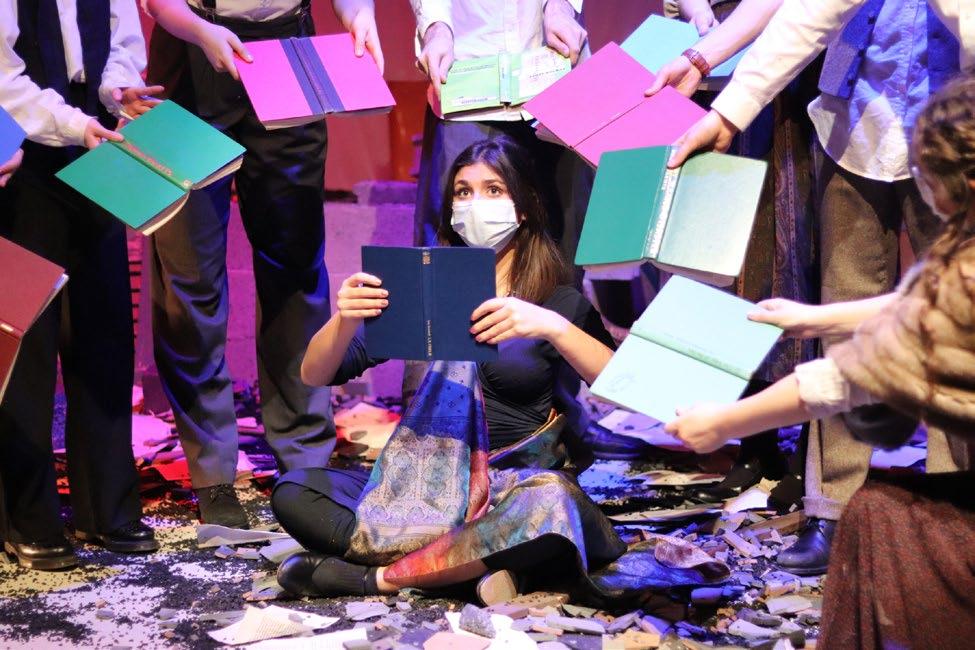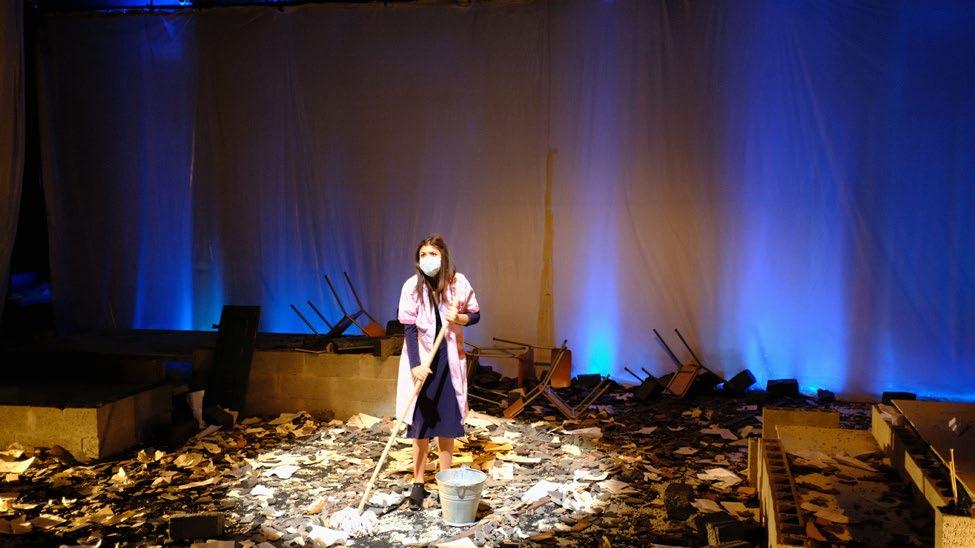
7 minute read
The Journal: Finding My Theatre Voice
By Aditi Soni
(Yr 12 IB DP Theatre student)
Advertisement
A journal in theatre is steeped in reflection, growth, self-expression and/or self-exploration. As an IB theatre student, journaling has been requisite to identifying areas for improvement. As a theatre-maker, journaling has been essential to helping me find my theatrical voice. A journal is a constant debate within the mind of the creator, a transformative discussion between the voice of your past mind and the voice you are beginning to express. Personally, I see journalism as a physical manifestation of the metamorphosis of my theatrical brain paired with the amplification of analytical skills. However, despite my emphasis on personal transfiguration surrounding mind and work, journaling is also the process of deliberating around the ideas and works of others. This is essential for an artistic mind to grow and develop. For example, I used this style of journaling whilst devising Fragments Fragments emerged from stories within our company, ten stories of powerful women, our ancestors. It was an exploration of diversity, memory transformation. During this process, I used many works of theatre to help sprout ideas for our piece and expand my conception of expression. This could later be connected to the stories we were telling. For example, I reflected on a piece called Particles, directed by Jack Hesketh, who used animation, light and object transformation to express movement through time in relationships.
‘I think the intention of this moment is to show dominance and reliance in some relationships - whether that's a relationship with an object, person or emotion. It's a visualisation of the control a relationship has over you, the control you allow it to have over you. The moment uses a chair. A chair is an object you use to rest to take the strain off your legs, it’s an object that shrinks you, lowers your level, taking away some of your power. The chair is used to show that in relationships you settle, you stop fighting and sit, compromise or sometimes fully give in. Its use with levels also shows the loss in power, although the actor sitting may still be the focal point you can see the actor behind towering over them, which not only takes away from their size but makes them look submissive therefore giving the power and weight to the actor behind.'
This reflection gave grounds for me to explore object transformation which then became a central idea in Fragments. It furthered my ideas and understanding of levels. This allowed me to then refer back to my own devising.
‘Relation to Fragments: Kantas story, the theme of control and independence. Kanta is independent and self-reliant. When her qualifications are stripped from her the desire to be able to control her own life and profession is prevalent. There is a point of realisation that she has to give in to the now overwhelming power this country has over her. It leads us to an understanding of the new form of dismissal she will experience due to her race and gender. The image of the struggle represents her disbelief and her hanker for having what she once had in Kenya. The sitting then further represents her releasing that which she will have to start from the very beginning again, from the lowest level, to achieve what she once did again.’

When relating and linking your work to the works of others it is crucial that you look precisely at key themes, or techniques, used. You are not stealing ideas, you are just looking at how you may express emotions through new forms of theatre or interesting takes on theatrical techniques. It's important that one keeps this simple. You are not writing a final scene whilst using this form of relationship but learning how to incorporate practices into your work.
Another form of journalism is overall self-reflection of a specific moment where you see an overall transformation in your work as you manage to highlight how your thinking has changed towards your piece. It's a point of realisation in writing, an area highlighting the entirety of your growth, the challenges you've overcome, the amendments you've made and the journey you've traversed in your work.
‘During the last 10 days I, as a theatre-maker, have been exploring the story of Magda Lazar, Valeria's (a member of our company) Great Grandmother. Throughout this time period, we have been working to show her story through Magda's perspective whether that's emotional, reactivity or even, to a certain extent, literally. Despite the flood of ideas and scene proposals our group managed to have, we struggled to find variety in the presentation of these moments, which in turn affected the impact, as it drained the moments of contrast. This caused our moments to be repetitive. So in general, the challenge we faced was with the overall impact of our collection of work. This general problem was brought out after the creation of the movement piece surrounding the loss of Magda's husband. The piece lacked variety in speed, force and multifariousness which bled the emotional impact of the piece. Initially, we were happy with the movement sequence we used. It wasn't until we got an outside perspective that we realised that the intention and significance of the moments weren't coming through. Despite the fact that our sequence lacked variety we did create moments of merit in it. For example the point of climax, the box mime of memory. We saw we needed to refine some moments but, more importantly, add to the overall product.’
It is essential to define the moments you are working and reflecting on and what aspects of the moment you will later see in development. This helps show the clear transformation of your workings.
‘Moving forward in the creative process post feedback, we started looking back at moments where the impact could be added through techniques such as speed, weight and proximity. We looked at adding contrast through transitional moments, using each other and the stage to show points of change, whether that's a change in character or emotion. An example of this would also be the miming scene. Originally we used the sequence repetitively even in transition when surrounding Valeria, yet to contrast the pure simplicity and slower speed of this movement we used running and closer proximity to show the rapidity of the change in Magda's life and the overwhelming claustrophobic effect of it on her in an emotional sense. We also used the addition of an opening moment which contributed to contrast in levels and also separated the chorus for Magda (Valeria) therefore furthering the ideas surrounding unfamiliarity in the piece which in turn contributed to the isolationist intent of the moment. Speed was also added to the solo piece following the point of climax to show the progression, or lack thereof, of the emotional state of Magda. The unified acceptance of the need for development, especially surrounding the apogee of the piece, truly fuelled us collectively to dissect each individual moment, deciding where or what was relevant and contributing to the overall impact.’

In my opinion, when working with a company it's essential to show how you've grown together - what aspects you've worked on to ensure you see a clear change in the overall scene. This will then lead you to discuss how you've changed in relation to the scene and what you contributed to the change. This shows how your initial state has developed.
‘Individually my contributions came through on a very physical level, by this I mean exploring ways of amplifying moments through the exploration of physical movements. Specifically, Maya and I choreographed the skeleton of the additional ‘scene’, the scene representing death and its physical impact on those who are affected by it. We explored being physically uncomfortable in unnatural positions, we wanted to show the contrast between the natural presence of death and the almost unnatural feelings it bestows on every part of the body, the control and agony grief put onto a human. I thought the inclusion of breath was important, especially uneasy breath, the struggle of life in a body that is so alive with pain. A lot of ideas for this sequence were explored physically and then analysed from an outside perspective within the group, someone not performing them. We did this as this is how we originally spotted points of weakness within our performance.’
To conclude the reflection process, I would like to discuss how the process enriched my theatremaking knowledge and my understanding of our piece. I think on a basic level the reflective process surrounding the extension of a moment through speed, level and proximity truly taught me the importance of contrast, in terms of communication of our intention. Additionally, it taught me how to edit a moment, it taught me that a moment doesn't have to be completely scrapped to fit your intention, the editing process and analytical process of specifying the intention of each movement are so important. Looking specifically at this moment we took the key points in our original piece and looked at how they showed the journey, emotions and authenticity of Magda's husband's death. Furthermore, this moment taught me how our piece was increasingly becoming a movement piece and a little repetitive, it taught me to explore more unusual forms of theatre, with the removal of dialogue.’
When discussing an overall change it's essential to show a conclusion, to highlight what you've truly learned and how you've grown as an individual and as a company.
Journaling is a personal process. When one journals, whatever they reflect upon will help them grow as growth comes through personal reflective comments. As theatre makers growth is indispensable to be able to create new, beautiful, cathartic pieces which change and develop with time. As the world evolves so do our truths as humans and theatre is a place where the truth of our time is unveiled visually, where expression reveals the world in its newest form. It is our duty as the artists of the world to show and question this developing world.
‘An artist is a sort of emotional or spiritual historian. His role is to make you realise the doom and glory of knowing who you are and what you are. He has to tell because nobody else in the world can tell what it is like to be alive.’
James Baldwin 1
1 Thomas, Riley David. “14 Quotes about the Purpose of Theater.” StageLight Magazine, 6 Mar. 2019, Stagelight Magazine










